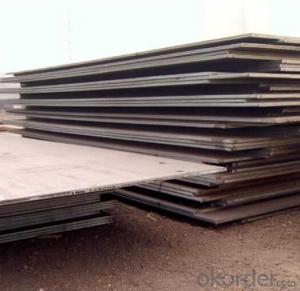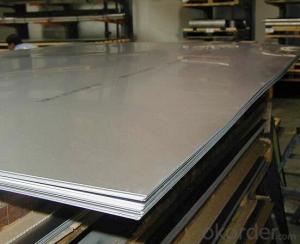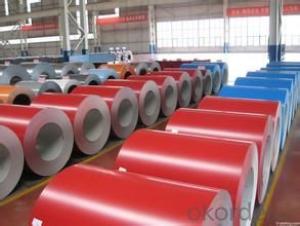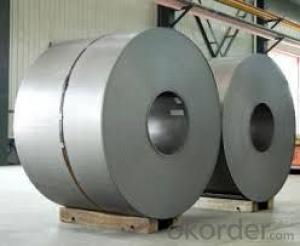Stainless Steel Sheet/Plate of China Supplier 316 AISI
- Loading Port:
- Tianjin
- Payment Terms:
- TT OR LC
- Min Order Qty:
- 50 m.t.
- Supply Capability:
- 50000 m.t./month
OKorder Service Pledge
OKorder Financial Service
You Might Also Like
Item specifice
1.Description of steel sheet:
Stainless steel types 304 and 304L.Type 304 stainless steel material is a kind of common stainless steel materials, corrosion prevention is b
2.Features of steel sheet:
304 stainless steel has good corrosion and corrosion resistance and good resistance to intergranular corrosion. For oxidizing acid, obtained in the experiment, the concentration of 65% or less under the boiling temperature of nitric acid, 304stainless steel has a strong corrosion resistance. To most organic and inorganic acid and alkali solution with good corrosion resistance ability.
All stainless stock can be delivered mirror polished if required
3.Data of steel sheet:
| Chemical Composition(in percentage) | ||||||||
| Grade | C | Mn(Max) | P(Max) | S(Max) | Si(Max) | Cr(Max) | Ni(Max) | Mo(Max) |
| 201 | 0.15 | 5.5-7.5 | 0.06 | 0.03 | 1 | 16.0-18.0 | 3.5-5.5 | |
| 202 | 0.15 | 7.5-10.5 | 0.06 | 0.03 | 1 | 17.0-19.0 | 4.0-6.0 | |
| 304 | 0.08 | 2 | 0.045 | 0.03 | 1 | 18.0-20.0 | 8.0-10.5 | |
| 304L | 0.03 | 2 | 0.045 | 0.03 | 1 | 18.0-20.0 | 8.0-12.0 | |
| 310S | 0.08 | 2 | 0.045 | 0.03 | 1.5 | 24.0-26.0 | 19.0-22.0 | |
| 316 | 0.08 | 2 | 0.045 | 0.03 | 1 | 16.0-18.0 | 10.0-14.0 | 2.0-3.0 |
| 316L | 0.03 | 2 | 0.045 | 0.03 | 1 | 16.0-18.0 | 10.0-14.0 | 2.0-3.0 |
| 317 | 0.08 | 2 | 0.045 | 0.03 | 0.75 | 18.0-20.0 | 11.0-14.0 | 3.0-4.0 |
| 317L | 0.03 | 2 | 0.045 | 0.03 | 0.75 | 18.0-20.0 | 11.0-15.0 | 3.0-4.0 |
| 321 | 0.08 | 2 | 0.045 | 0.03 | 0.75 | 17.0-19.0 | 9.0-12.0 | |
| 409 | 0.08 | 1 | 0.04 | 0.01 | 1 | 10.5-11.75 | 0.5 | |
| 410S | 0.08 | 1 | 0.04 | 0.03 | 1 | 11.5-13.5 | 0.6 | |
| 410 | 0.15 | 1 | 0.04 | 0.03 | 1 | 11.5-13.5 | 0.75 | |
| 420 | 0.35 | 0.5 | 0.035 | 0.015 | 0.5 | 12.0-13.0 | 0.2-3.0 | |
4.Image of steel sheet:
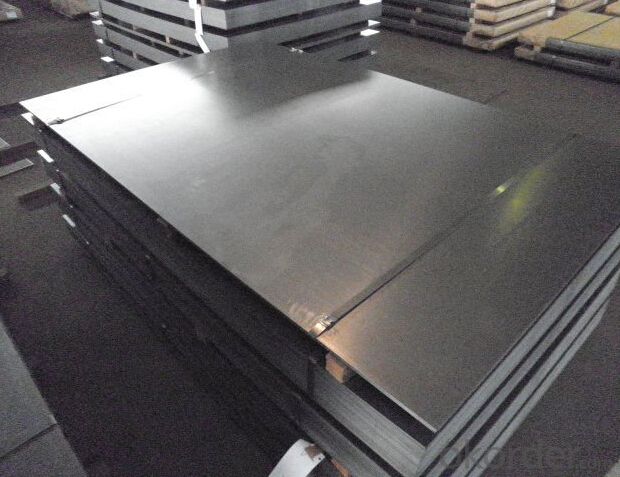
5.FAQ
We have organized several common questions for our clients,may help you sincerely:
①How about your Warranty?
Warranty: 1-Year for the whole light. Warranty is based on correct storage, installation, using and maintenanc
②How to guarantee the quality of the products?
We have established the international advanced quality management system,every link from raw material to final product we have strict quality test;We resolutely put an end to unqualified products flowing into the market. At the same time, we will provide necessary follow-up service assurance.
③How long can we receive the product after purchase?
In the purchase of product within three working days, We will arrange the factory delivery as soon as possible. The pecific time of receiving is related to the state and position of customers.Commonly 7 to 10 working days can be served.
- Q:Can the steel sheets be used for storage cabinets?
- Indeed, storage cabinets can be constructed using steel sheets. Steel, a robust and enduring material, is frequently employed in the fabrication of cabinets and alternative storage options. By manipulating steel sheets, one can effortlessly fashion them into the preferred dimensions and style for cabinets, resulting in a resilient and dependable storage solution. Furthermore, steel possesses resistance to corrosion, rendering it ideal for preserving a multitude of items and guaranteeing the cabinets' durability.
- Q:What are the different surface treatments for steel sheets?
- Steel sheets offer a range of surface treatments, each designed for specific purposes and offering unique advantages. Some commonly used treatments include: 1. Hot-dip galvanizing: Immersing the steel sheet in molten zinc forms a protective layer, providing excellent corrosion resistance. This treatment is ideal for outdoor applications like roofing, fencing, and automotive parts. 2. Electroplating: Using an electric current, a thin layer of metal such as chromium, nickel, or zinc is deposited onto the steel sheet. Electroplating enhances the appearance, corrosion resistance, and can improve wear resistance. 3. Powder coating: Dry powder is applied to the steel sheet and then baked to create a durable, smooth, and uniform finish. Powder coating offers excellent corrosion and impact resistance, and comes in various colors and textures, making it suitable for architectural, automotive, and appliance uses. 4. Painting: Applying paint to the steel sheet provides aesthetic appeal and protects against corrosion. Different types of paints, such as epoxy, polyurethane, or acrylic, can be used based on desired appearance and environmental conditions. 5. Passivation: This chemical treatment removes impurities and contaminants from stainless steel sheets, improving their corrosion resistance against oxidation and staining. 6. Electropolishing: By immersing the steel sheet in an electrolyte bath and applying an electric current, a thin layer of material is removed, resulting in a smoother, brighter surface that is more resistant to corrosion. These examples demonstrate the variety of surface treatments available for steel sheets. The most suitable treatment depends on factors like intended application, desired appearance, corrosion resistance requirements, and budget. Seeking advice from a steel sheet supplier or surface treatment specialist can help determine the optimal treatment for specific needs.
- Q:What is the difference between a galvalume and galvanized steel sheet?
- The coating applied to the surface of galvalume and galvanized steel sheets is what sets them apart. Galvalume steel sheets are coated with an aluminum-zinc alloy, whereas galvanized steel sheets are coated with zinc. The coating on galvalume steel sheets offers better corrosion resistance compared to galvanized steel sheets. The combination of aluminum and zinc forms a protective barrier that prevents rusting and corrosion, even in harsh environments. Moreover, galvalume steel sheets have superior heat reflectivity compared to galvanized steel sheets. This makes them more energy-efficient in hot climates, as they reflect a larger portion of the sun's heat, reducing cooling expenses. Additionally, galvalume steel sheets have better resistance to scratches and fingerprints due to their unique coating composition. This makes them more visually appealing and easier to maintain in comparison to galvanized steel sheets. When it comes to price, galvalume steel sheets are generally costlier than galvanized steel sheets due to the added benefits and higher quality of the coating. However, the long-term cost-effectiveness of galvalume steel sheets can outweigh the initial higher purchase price. Overall, while both galvalume and galvanized steel sheets offer some level of corrosion protection, galvalume steel sheets provide superior corrosion resistance, heat reflectivity, and aesthetic appeal. Therefore, the choice between the two depends on the specific requirements of the project and the environmental conditions the steel sheet will be exposed to.
- Q:What are the environmental impacts of steel sheet production?
- The environmental impacts of steel sheet production include the extraction of raw materials such as iron ore, which can lead to deforestation and habitat destruction. The mining process also consumes large amounts of energy and water, contributing to greenhouse gas emissions and water pollution. Additionally, steel production involves the release of air pollutants, such as carbon dioxide, sulfur dioxide, and nitrogen oxides, contributing to climate change and air pollution. Waste generated during the production process, such as slag and dust, can also have negative impacts on soil and water quality if not properly managed.
- Q:How do steel sheets perform in terms of thermal expansion?
- Steel sheets have a relatively low coefficient of thermal expansion, meaning they expand and contract less than many other materials when exposed to temperature changes. This property makes steel sheets ideal for applications where dimensional stability is crucial, as they are less likely to warp or distort due to thermal fluctuations.
- Q:What are the common lengths of steel sheets?
- The common lengths of steel sheets vary depending on the specific industry and application, but they typically range from 6 to 12 feet.
- Q:What are the dimensions of steel sheets?
- The dimensions of steel sheets vary depending on the specific application and manufacturer. However, steel sheets typically come in standard sizes ranging from 4 feet by 8 feet (1.2 meters by 2.4 meters) to 6 feet by 10 feet (1.8 meters by 3 meters). Additionally, thicknesses can range from 0.015 inches (0.4 millimeters) to over 1 inch (25 millimeters), again depending on the intended use.
- Q:Can steel sheets be bent or curved?
- Indeed, steel sheets possess the capability to undergo bending or curving. Steel, being a pliable substance, can be molded or shaped effortlessly without any risk of fracture or fissure. This particular characteristic enables steel sheets to be contorted or arched into diverse configurations and inclinations, contingent upon the sought-after result. The procedure of bending or curving steel sheets usually entails the utilization of specialized apparatuses, including press brakes or rollers. These instruments exert pressure on the steel sheet, compelling it to flex or curve in accordance with the desired specifications. The ability to manipulate steel sheets in this manner renders them exceedingly adaptable and extensively employed in industries such as construction, automotive, and manufacturing.
- Q:Can steel sheets be used in medical applications?
- Yes, steel sheets can be used in medical applications. They are often used in the manufacturing of medical instruments, surgical tools, and equipment due to their durability, corrosion resistance, and ability to be sterilized.
- Q:What's the difference between profiled steel sheet and color steel plate?
- A kind of color steel plate is in fact, but now the normal pressure plate to floor plate thickness in 0.7-1.5MM is used in galvanized coil is the main steel structure building, airport, train station, subway station, shopping malls, etc. some of the large span steel structure.
1. Manufacturer Overview |
|
|---|---|
| Location | |
| Year Established | |
| Annual Output Value | |
| Main Markets | |
| Company Certifications | |
2. Manufacturer Certificates |
|
|---|---|
| a) Certification Name | |
| Range | |
| Reference | |
| Validity Period | |
3. Manufacturer Capability |
|
|---|---|
| a)Trade Capacity | |
| Nearest Port | |
| Export Percentage | |
| No.of Employees in Trade Department | |
| Language Spoken: | |
| b)Factory Information | |
| Factory Size: | |
| No. of Production Lines | |
| Contract Manufacturing | |
| Product Price Range | |
Send your message to us
Stainless Steel Sheet/Plate of China Supplier 316 AISI
- Loading Port:
- Tianjin
- Payment Terms:
- TT OR LC
- Min Order Qty:
- 50 m.t.
- Supply Capability:
- 50000 m.t./month
OKorder Service Pledge
OKorder Financial Service
Similar products
New products
Hot products
Hot Searches
Related keywords
